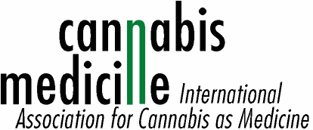IACM-Bulletin
11 October 2009
[International Association for Cannabinoid Medicines (IACM)
>http://www.cannabis-med.org]
Am Mildenweg 6
D-59602 Ruethen
Germany
Phone: +49 (0)2952-9708571
Fax: +49 (0)2952-902651
Email: info@cannabis-med.org
Abstract book of the IACM Conference available
1. IACM: General Meeting changes name to International
Association for Cannabinoid Medicines
At its General Meeting on 2 October the IACM changed its name
and the statutes, and elected Ethan Russo from the USA as the
new chairman. New members of the IACM Board of Directors
are Manuel Guzman from the University of Madrid, Spain, and
Arno Hazekamp from the Dutch Association for
Legal Cannabis and its Constituents as Medicine (NCSM). The
following Board Members were re-elected: Roger Pertwee (UK),
Ethan Russo (USA), Willy Notcutt (UK), Franjo Grotenhermen
(Germany), Daniela Parolaro (Italy), Mark Ware (Canada), and
Rudolf Brenneisen (Switzerland). Clare Hodges (UK) was re-
elected as patient representative of the IACM.
The IACM honoured four persons for special achievements
regarding the re-introduction of cannabis and cannabinoids as
medicine. The IACM Award 2009 for Clinical Research goes to
Mark Ware, the IACM Award 2009 for Basic Research goes to
Manuel Guzman, the IACM Award 2009 for Young Researchers
goes to Istvan Katona, and the IACM Special Award 2009 goes
to Ethan Russo.
The General Meeting noted that the development of medicines
that influence the endocannabinoid system comprises an
increasing number of substances and the IACM should be
attractive to all scientists, physicians and others interested in the
medical use of substances that influence the endocannabinoid
system. It was decided to choose a new name that reflects this
development. The aims of the IACM are now more clearly
expressed. The new statutes say: “The aim of the association is to
advance knowledge on cannabis, cannabinoids, the
endocannabinoid system, and related topics especially with regard
to their therapeutic potential. The mission is achieved in particular
through the following actions:
Support for research into cannabis products and the
endocannabinoid system;
Promotion of exchange of information between researchers,
health care practitioners, patients and the public;
Preparation and dissemination of reliable information on the
pharmacology, toxicology and therapeutic potential of cannabis
and modulators of the endocannabinoid system;
Monitoring and documentation of national and international
developments with respect to cannabinoid therapeutics;
Co-operation with other organisations and associations sharing
the mission and goals of the IACM”;
2. IACM: New results from clinical research at the IACM 2009
Conference
About 90 scientists, doctors, and others participated in the 5th
IACM Conference on Cannabinoids in Medicine in Cologne,
Germany, on 2-3 October. Here are some results from clinical
research presented at the conference.
(1) Dr. John Zajicek from Peninsula College of Medicine in
Plymouth, UK, presented data on a placebo-controlled study on a
capsulated cannabis extract (Cannador) in 279 patients with
multiple sclerosis who suffered from troublesome muscle
stiffness. The rate of relief in muscle stiffness after 12 weeks
was almost twice as large under cannabis extract compared to
placebo (29.4 per cent versus 15.7 per cent). Equivalent results
were also found in rates of relief for pain, spasms and sleep.
(2) Dr. Donald Abrams from the University of California in San
Francisco, USA, presented data on the additional use of inhaled
cannabis in 21 patients on stable doses of long-acting opioids
(morphine or oxycodone). Participants were exposed to vaporized
cannabis three times daily for three days. Researchers concluded
that “co-administration of vaporized cannabis in subjects on stable
doses of morphine or oxycodone appears to enhance analgesia.”
Cannabis also tended towards lowering concentration of the
opioids in blood.
(3) Dr. Mark Ware from McGill University of Montreal, Canada,
presented results from the COMPASS study, which looked at the
safety of cannabis in the treatment of pain. The study investigated
side effects of standardized herbal cannabis dispensed to 215 pain
patients for one year. Compared to 216 controls who received no
cannabis there was no difference in serious adverse effects. The
average cannabis dose was 1.86 grams per day. Researchers
concluded that “cannabis use for chronic pain over one year is not
associated with major changes in lung, endocrine, cognitive
function or serious adverse events.”
(4) Dr. Vincent Maida from the University of Toronto, Canada,
presented data from an observational study on nabilone, a
derivative of THC, in the management of advanced cancer
patients. Data from 112 patients (47 nabilone, 65 non-nabilone
treated) met criteria for analyses. The pain scores and total opioid
use in nabilone treated patients were significantly reduced
compared with patients who did not receive nabilone. Nausea and
overall distress were also reduced by nabilone.
More in the reader of the conference
3. News in brief
USA: Colorado
According to a newspaper report the amount of people registered
to legally use cannabis for medicinal purposes in Colorado has
nearly tripled in the last year to just above 11,000. That number is
expected to grow to 15,000 by year’s end. (Source: Aspen Daily
News of 8 October 2009)
Science: Diabetic neuropathy
According to clinical research at the Royal Hallamshire Hospital
in Sheffield, UK, a standardized cannabis extract (Sativex) did not
reduce pain in 30 patients with diabetic neuropathy. In this
controlled trial participants received daily Sativex or placebo.
There were no significant differences in pain relief and other
outcome measures. (Source: Selvarajah D, et al. Diabetes Care
2009 Oct 6. [Electronic publication ahead of print]
Science: Neuropathic pain
According to animal research at the University of Naples, Italy, a
selective CB2 receptor agonist reduced neuropathic pain after
nerve injury. The treatment with the cannabinoid reduced
inflammation. (Source: Luongo L, et al. Neurobiol Dis 2009 Oct 2.
[Electronic publication ahead of print])
Science: Detection of cannabis use
According to research at the National Institute on Drug Abuse in
Baltimore, USA, THC may be detectable for more than 6 days
after last cannabis use in blood of regular users of cannabis. Of
25 participants nine chronic users (36 per cent) had no
measurable THC during 7 days of cannabis abstinence; 16 had at
least one positive THC of more than 0.25 ng/ml, but not
necessarily on the first day. On day 7, 6 full days after controlled
cannabis abstinence, six participants still displayed detectable
THC concentrations and all 25 had measurable concentrations of
THC-COOH. The highest observed THC concentrations at start
of the study (day 1) and day 7 were 7.0 and 3.0 ng/ml,
respectively. (Source: Karschner EL, et al. Addiction 2009 Oct 5.
[Electronic publication ahead of print])
Science: Cannabis and alcohol use
According to a study at the Yale University School of Medicine in
New Haven, USA, with 28 daily cannabis users those with past
alcohol abuse or dependence increased their alcohol use during a
period of cannabis abstinence. Participants were subjected to a 13-
day cannabis abstinence period and those with past problematic
alcohol use increased alcohol use by 52 per cent. (Source: Peters
EN, et al. Drug Alcohol Depend 2009 Sep 22. [Electronic
publication ahead of print])
Science: Heritability of cannabis use
According to a study at the University of Amsterdam with 3115
twins there was a moderate genetic influence (44 per cent) on
initiation of cannabis use. The remaining causes were explained
by environmental influences shared by twins (31 per cent) and by
environmental factors experienced only by the person
investigated (24 per cent). (Source: Vink JM, et al. Addict Behav
2009 Sep 12. [Electronic publication ahead of print])
Science: Anxiety
According to a study at the Schizophrenia Research Institute in
Darlinghurst, Australia, chronic but not acute administration of the
plant cannabinoid cannabidiol (CBD) caused anxiolytic and
antipsychotic effects in mice. (Source: Long LE, et al. Int J
Neuropsychopharmacol 2009 Sep 29. [Electronic publication
ahead of print])
(More at the IACM-Bulletin archives)




 Creative Commons Attribution
Creative Commons Attribution